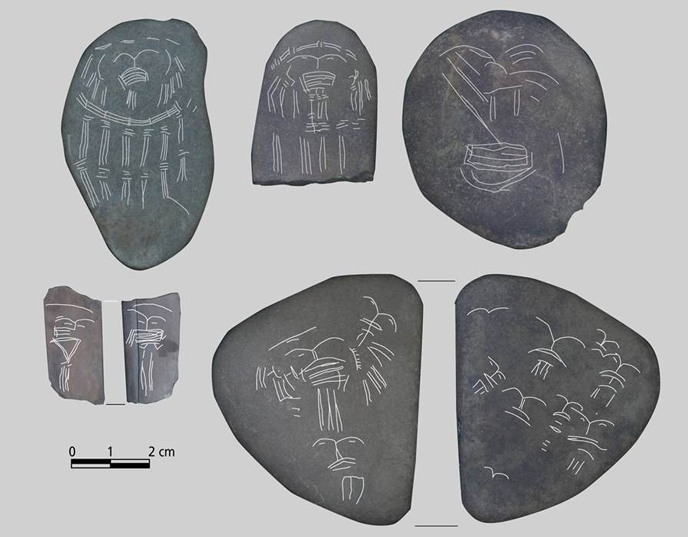From 2002-2003, working with the Council of Katmai Descendants, NPS archaeologists partially excavated one of these 20 sites in an attempt to answer research questions and learn about the site before sections were lost to erosion. Some of the artifacts found during this excavation were delicately designed incised pebbles.

What do the etchings on these pebbles represent? NPS photo.
38 incised pebbles were found during excavation—34 of which were from one feature. All of these local indurated sedimentary pebbles have stylized intricate anthropomorphic designs incised onto them. While all of the designs are of a similar style, no two pebbles are exactly the same. While it is impossible to postulate what design elements such as arcs, clusters, lines, dots, triangles, diagonals, and tree-like patterns might mean, archeologists have suggested that they could represent facial features such as eyebrows, eyes, or mouths or clothing and personal adornment such as headgear, necklaces, or jewelry. It is also possible these designs are not anthropomorphic at all but rather part of a counting or tallying system; or perhaps they represent mythical or magical creatures. Along the same lines, the function of these pebbles is impossible to determine. They do not appear to be tools, so perhaps they were either of a ceremonial function or game pieces.
What is very interesting is that hundreds of these artifacts have been recovered from Kodiak Island in various sites, and similar pebbles have been excavated in Aniakchak National Monument. While the designs of the Kodiak and Aniakchak pebbles have different elements in them, they are similar, suggesting a similar function. Generally, the Kodiak and Aniakchak incised pebbles date to the Koniag period (AD 1300-1500).
These similarities suggest a past connection between the people at Brooks River, Kodiak, and Aniakchak: Could the people of Brooks River be from Kodiak? Could the designs have been inspired by meetings between the Brooks villagers and those from Kodiak or Aniakchak? If so, did they meet frequently? Rarely? Were the meetings friendly?

On the left is a photo of what one of the pebbles looks like to the naked eye. On the right is a photo that has been enhanced to show the designs etched into the surface—quite amazing! NPS Photos.
These pebbles are very lightly etched, and very difficult to see by the archaeologists when excavating—they are even difficult to see in the lab with good lighting. If you want to read more about this excavation, please go to https://www.nps.gov/archeology/sites/npSites/brooksRiverCutbank.htm.
